Lunch with Win Percy
He was already 31 when his career began in earnest, but a late start was no impediment for one of racing's true gents
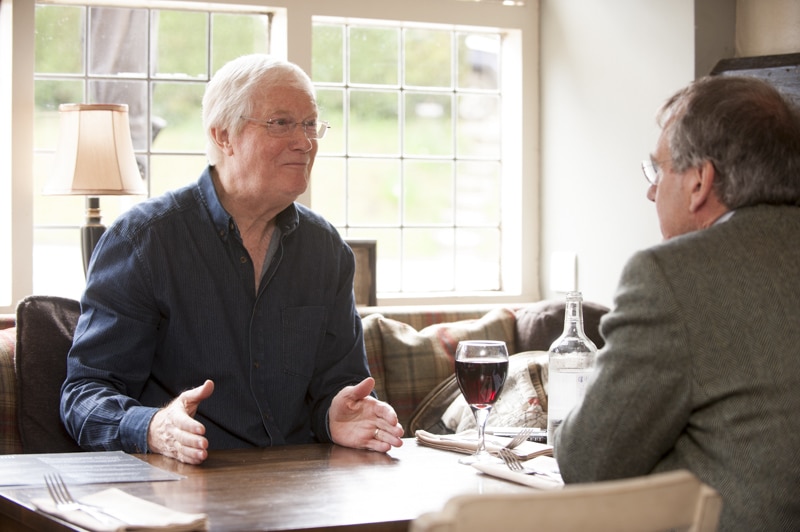
Charles Best
Analyse the human make-up of successful racing drivers, and you uncover fascinating variety. There’ll always be a powerful will to win, of course, although this may manifest itself in differing ways. Plus you’d expect aggression: maybe openly on display, maybe carefully hidden when out of the cockpit. And there’s bound to be deep self-belief, a crucial ingredient driving the racer on. Less often nowadays do you find a quality that, I suggest, is becoming rarer throughout all 21st century sport: an innate sense of decency. You find that in Win Percy.
Win’s start in life was humble, as the farm labourer son of a farm labourer. His start in racing was humble, too: in an old Ford Anglia on his local stock car track. Yet he went on to become one of the most successful racing drivers in his category in the world, a multiple champion in touring cars and a frontrunner in Group C. Having escaped unhurt from a terrifying 200mph Le Mans crash, his 28-year career as a professional racer was only ended, with dreadful irony, by a tragic medical error after he put his back out in the garden. He was told he would never walk again, but he has met this new challenge with extraordinary courage and determination, and success. He and his wife Rosemary now live in southern Spain, but he also keeps an apartment in Prince Charles’s model village of Poundbury, on the Dorset coast. From there we drive to the Wise Man at West Stafford, a proper village pub that greets us with home-made steak and kidney pie and an honest glass of red.
Winston Walter Frederick Lawrence Percy is a West Countryman. He was born in 1943 in Tolpuddle, and his voice has never lost its gentle Dorset burr. “My parents were very poor: Dad was a farm worker and we lived in a farm cottage. At school my form master, Mr Stanley, said, ‘Winston, I have to be honest. You’re a waste of space here. I don’t know what you’re going to do with your life, but I’m doing you no good at all.’ So I left school at 14 and started on the farm, driving a tractor. With the agricultural machinery I was in my element, because I could fix things, and I was quite happy. I got hold of an old motorbike, an Ariel Colt, and of course I took it to bits to see how it worked. Then Mr Ayers, who ran the little village garage next to the pub, wanted a lad to help him out. He offered me £3 a week, but he said, ‘I won’t be able to keep you when they build the bypass around Tolpuddle, because my petrol sales will drop off.’ This was 1959. The bypass got built in 1996.
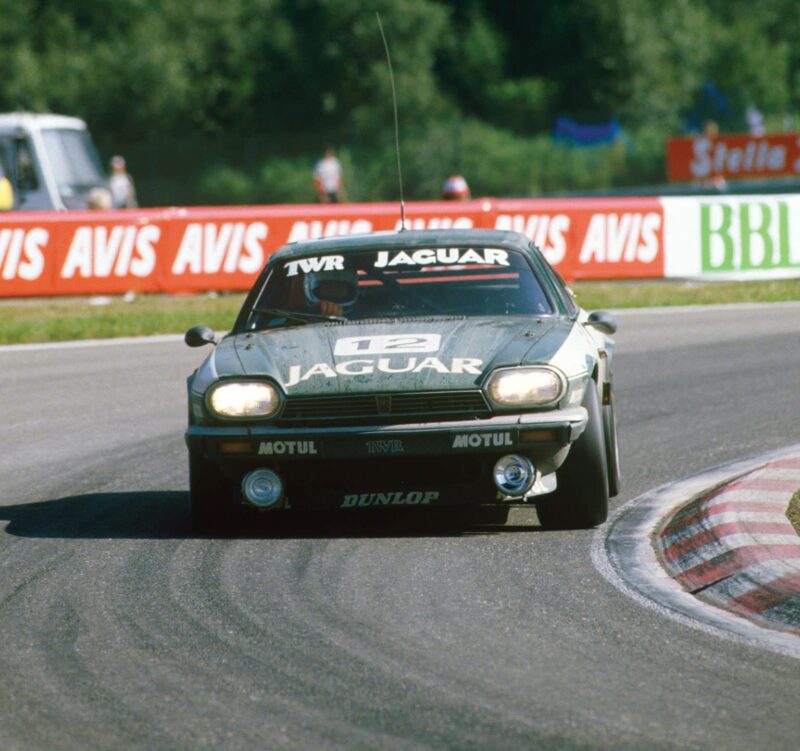
Win winning: sharing a Jaguar XJS with Tom Walkinshaw and Hans Heyer in the 1984 Spa 24 Hours
Motorsport Images
“I had five years there, and I learned to do everything: relining clutches and brakes, redoing armatures in dynamos and starters, white metal bearings, all the things a mechanic won’t do nowadays because he’ll just use a replacement part. And I was on the breakdown truck. In the middle of the night Mr Ayers would tap on my bedroom window, ‘Come on, Win, crash’, and we’d go and do the recoveries. By now I’d scraped together enough for an old Morris Minor. One evening I was hanging around in Dorchester with the other lads and a new Ford Zodiac Convertible pulled up on L-plates, a girl driving it with an instructor giving her a lesson. I persuaded her to interrupt her lesson for a coffee at the Orlando Cafe. We talked, and we just clicked. That was Rosemary. We got engaged on my 21st birthday, and we were married the following year.
“The Zodiac was Rosemary’s mother’s, but meanwhile I managed to trade up to a Sunbeam Rapier. I had it on HP, in my mum’s name because I couldn’t get insurance for it. But it came to a sticky end. One night we were leaving the Orlando and my friend, whose dad had bought him a Mini-Cooper, said, ‘I don’t reckon much to your Rootes rubbish.’ That was a challenge, and on a downhill bend near Puddletown I lost the lot. Took down a telegraph pole, which wiped out the left-hand front wing and suspension, bounced back onto the road as far as the next telegraph pole, and tore the whole side out. I got out with barely a scratch. My little transistor radio was in the hedge, still playing Radio Luxembourg.
“My mate in the Cooper took me back to Tolpuddle for the breakdown so I could hide the evidence, but by the time we got back our local copper, Sergeant Lofty Fagg, had arrived. I told Lofty I’d been doing 40mph and a car coming towards me hadn’t dipped its lights and had dazzled me. He said, ‘You must think we’re stupid.’ Next morning a brown envelope arrived, marked Dorset Constabulary. I stared at it all morning, didn’t dare open it, I was sure it was a summons. Finally I looked inside. On a sheet of police paper Lofty had written, ‘We’ll have you next time, you young bugger.’
“After the Rapier I got a 105E Anglia, totally standard apart from a couple of spot lights to make it look like a rally car. One evening in 1964 Rosemary and I go down to the stock car track at Weymouth. They’re short of entries, and they put out an announcement: who’d like to take their own car around the track? Three laps against the clock, a trophy for the winner.
I say to Rosemary, ‘I’d like to have a go at this.’ She says, ‘Don’t be silly,’ but I borrow a crash helmet and round I go. I’m up against lots of more powerful cars, Mk 2 Jaguars, Vauxhall Crestas, but I win the trophy. And I can’t believe how much fun it is, driving sideways.
“The following week I joined my local motor club, the Woolbridge MC, and started doing everything I could with the Anglia: night rallies, autocross, slaloms. Rosemary loved it as well, and she was quick — as Barry Lee will tell you, because she beat him in rallycross. But she didn’t come as my navigator on rallies. We tried that once, and we fell out.
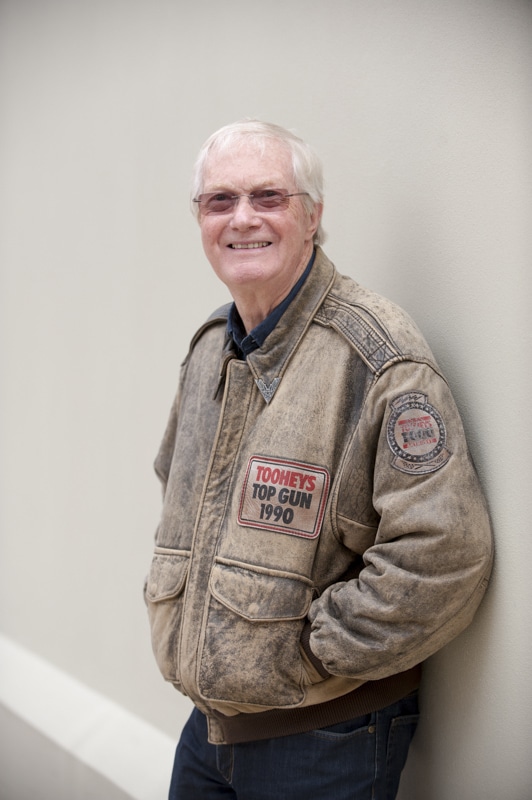
“By now I was working as a mechanic at the Renault garage in Weymouth. I had some success in local rallies, and then I started to do well in the Player’s No6 autocross series. The Anglia went from 997 to 1200, then 1500 five-bearing, then 1650, then twin-cam. I built the engines in the front room by the fire in the evenings and, without the £10 or £15 prize money that we’d usually win on Sundays, we’d struggle to get through the week. Our daughter was born in 1966, our son in 1969, and then the local squire up at Godmanstone Manor, Humphrey Mead, said to me, ‘If I put up the money and let you use my stables, you can do people’s engines and call yourself Wintune.’ So I gave up my safe job at the Renault garage and set up on my own. Our bread and butter was servicing road cars for the officers at Dorchester Prison, but the performance stuff grew and grew. We did autocross cars, even Formula Fords, and we built up about 15 Siva fibreglass Model T lookalikes. We made the one they used in the Dr Who TV series.
“Humphrey used to have some great parties at the Manor. I remember Innes Ireland squirting a hosepipe through one of the windows to try to get Duncan Hamilton out of bed, while I worked away in the stables thinking, ‘These people are mad.’ Wintune did all right, but then Humphrey’s wife went off with Peter Cadbury. Humphrey walked in one morning and said, Win, don’t write out any more cheques. I’m pulling my money out, I’m closing Wintune.’ I was devastated. But as one door closes another opens.
“After working for Tony Birchenhough at Dorset Racing, I took over the tenancy of his little National Benzole petrol site, Wey Valley Service Station. I took on a young mechanic, Danny Morgan, bought a Modsports MG Midget and did a couple of races. The local Datsun distributor let me have some stock, and over the winter of 1972/73 I took a Datsun 180B SSS off the forecourt, put a sumpguard on it, did the three televised rallycrosses at Cadwell Park against the likes of Barry Lee and Colin Malkin, and won all three. Then I washed off the mud, took off the sumpguard, put it back on the forecourt and sold it.
“Next I bought a Datsun 240Z, just a road car, but I heard about Spike Anderson who’d built up a racing 240Z called the Samurai. I went up to see him and agreed he should do mine. I raced it in 1973, and it went well — I particularly remember a wet race at Lydden Hill, when I beat the fast man in Modsports, one Dr Jonathan Palmer in a 3-litre Marcos. Then at the start of 1974 Spike comes on the phone. ‘I’ve built a full-race Samurai called Big Sam. For £50 a race you can drive it.’ We won the class in the Modsports Championship, beat Nick Faure in the AFN Porsche, and for 1975 Toyota asked me to run for them in the 1600 class of the British Saloon Car Championship, in a Celica prepared by Spike. And then, with me already 31 years old, it all just took off.
“The first round was Mallory Park in March. And it rained. I’ve always liked the wet; I suppose it was the autocross and rallycross experience that taught me how to go sideways. I won the 1600 class, and had a race-long battle with a 2-litre Escort. After the race we were celebrating in the paddock with the Toyota people, and this stocky, chunky guy pushes into our little group and says, in a Scottish accent, Win’s a funny name. This your first time in touring cars?’ Shakes my hand, and off he goes. I said, ‘Who’s that?’ They said, ‘That’s the guy in the Escort, Walkinshaw’.”
During the season Win won his class 10 times, took 10 lap records, was British class champion and very nearly won the title outright. Not bad for his first season in touring cars, and his second full season of circuit racing. In 1976 he did it again, but for 1977 he decided to move up to the big class, and went for a 3-litre Capri: “Quick, but it kept breaking. So I went back to a 1600 Celica, bought it myself for £2000 and prepared it with Danny, and Barry Hudson did the engine. I got £3000 sponsorship from Bradshaw Plant Hire [run by the family of long-time Williams F1 press officer Annie Bradshaw] and, including prize money and selling the car at the end of the season, we made a profit. Richard Lloyd’s Golf GTi won the class, but we beat it a couple of times and had some fastest laps.
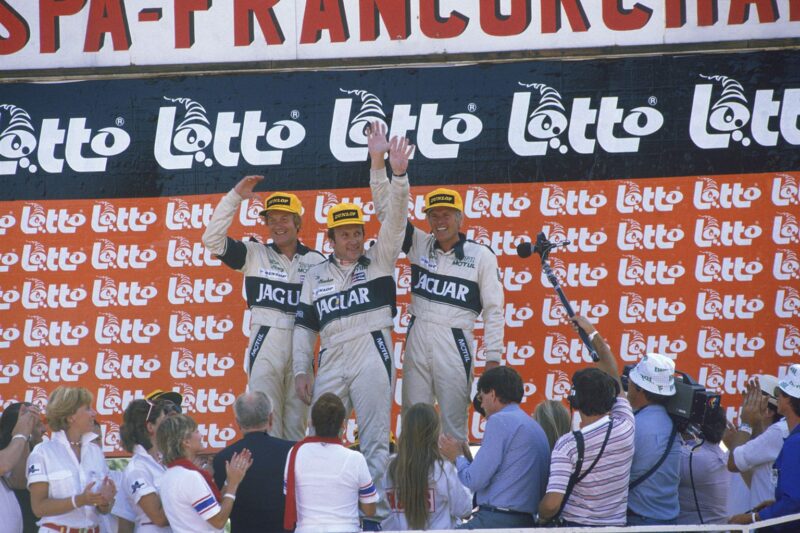
Celebrating XJS success in the 1984 Spa 24 Hours, with Walkinshaw and Heyer
Motorsport Iamges
“For 1979 Toyota re-signed me to drive the latest Celica, which was heavier, and still Richard Lloyd was the problem. But I was starting to beat him, and then came the British GP support at Silverstone. That was the only race in 33 years on the circuits that I was called up in front of the stewards.” On the second lap Gerry Marshall’s Dolomite and the Mazda of Tom Walkinshaw touched, and the Dolomite was launched into a frightening series of rolls. Marshall’s helmet came off during the accident. Lloyd and Percy were just behind: “Gerry rolled almost all the way from Stowe to Club. I saw his helmet bouncing down the road. Of course Richard and I both backed off, then the next lap I’m lining up to get him once we’re through the yellows and past the green flag — and then he jams on his brakes. I can’t help going by. I slow down, wave for him to come past again, but he won’t. So I get done.”
The week after the British GP debacle Win was invited to do his first overseas race: the Spa 24 Hours with Bristolian Vince Woodman and Somerset boy Jonathan Buncombe — “a good West Country team. It was the first race ever on the new Spa circuit. After 21 hours we were in third place, ahead of the Belga Capris of Gordon Spice and Chris Craft. Then the engine went. I also did six races in the BMW County Championship, and I think I won four of them.
“Then at Snetterton I was summoned to the Walkinshaw motorhome, and Tom offered me a Mazda drive for 1980. I said, ‘This isn’t just me driving for you for one season and then you dump me?’ He said no, it wasn’t. So we shook hands. It was the start of a long relationship.
“Tom offered me £6000, but he said he’d only pay me if I won the title. So I won the title.” In fact Win totally dominated his class in the Walkinshaw-prepared Mazda RX-7s — the regulations defining a touring car were fairly liberal then — and was crowned British Saloon Car Champion well before the end of the season. In 1981 he did it again, this time not only dominating his class but also taking two outright wins against the Walkinshaw-prepared V8 Rovers and the V6 Capris.
Then came a big blow. National Benzole pulled out of Wey Valley Service Station, saying it wasn’t selling enough petrol. “I was always a worrier, but I steeled myself to borrow more from the bank and bought the site, built a proper showroom and became a Mazda dealer. It’s nothing to do with me any more, but if you drive into Weymouth it’s there, doing well, and Danny, my old mechanic, still runs it.
“Meanwhile Tom seemed pretty happy with me. For 1981 he’d paid me £8000, and I was expecting more of the same for 1982. Then he says, ‘I can’t use you next year. We’re not going with Mazda any more, and I’ve already got my Rover drivers.’ I couldn’t believe it. I walk down the pitlane feeling very sorry for myself, and I bump into Mike Copeman from Toyota. He says, ‘Cheer up, champ. Why are you looking so dejected?’ I tell him, and he says at once, ‘We’ll have you back. £15,000.’ ‘I say, ‘Done,’ and we shake hands. I walk back up the pitlane, and Tom says, ‘Come on, let’s talk about next year.’ You don’t need to worry,’ I tell him, ‘I’m sorted. I’ve done a deal with Toyota. I’ve shaken hands on it.’ Tom says, ‘Well, you can just go and unshake. I’m putting you in a Rover next year.’ Tom had just been teasing me, trying to soften me up and get my price down. But I wouldn’t break my word to Toyota, so I drove for them and I was overall champion for the third year running, beating Tom’s Rovers.” In 11 starts he had 11 class poles, 11 wins, 11 fastest laps, job done. For 1983 Toyota moved into the big class with the 2.8 Supra, but development problems kept Win out of the running. But he won the Snetterton 24 Hours in a Porsche 928 with Andy Rouse and Tony Dron, and he was back with Walkinshaw for the Spa 24 Hours in a Jaguar XJS, sharing with Martin Brundle and Enzo Calderari and leading before the gearbox failed.
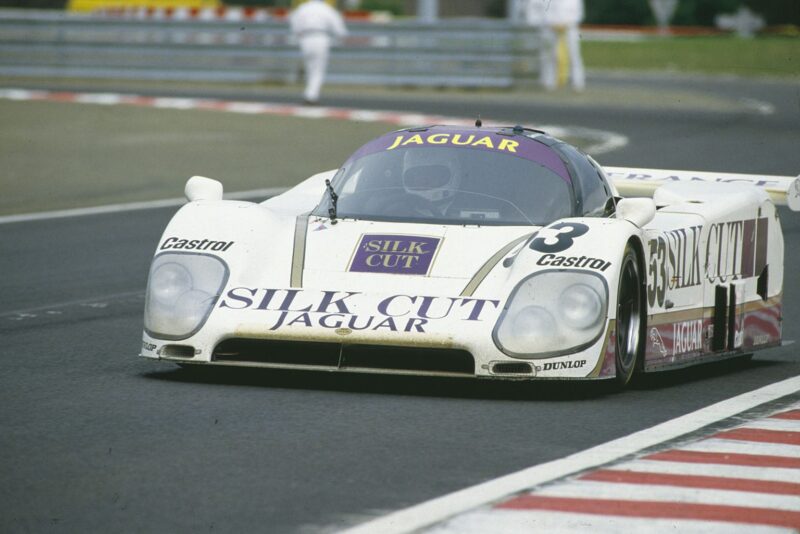
Percy made his Le Mans 24 Hours debut in 1986, sharing a TWR Jaguar XJR-6 with Gianfranco Brancatelli and Armin Hahne
Motorsport Images
For 1984 Walkinshaw had Win’s name back on a proper contract, to do the European Touring Car Championship in the TWR Jaguar XJSs. And Toyota hung onto him as well for any BTCC rounds that didn’t clash. “I went to places I’d never heard of, like Brno. In practice I’d say to Tom, ‘Can I have a bit more time in the car, get used to the track?’ He’d look at me and he’d growl, ‘Winston, if you don’t know the place in three laps, you’re no use to me.’ He expected you to learn any track in three laps, and then sit down and tell him what you thought about each corner. And to be honest, if you put your mind to it you could do it.
“First round was Monza, wet, we threw a fan belt. Second round was Vallelunga, wet, I was leading with Jean-Louis Schlesser, we threw a fan belt. I was getting fed up with this. Third round, Donington, which is hard work in an XJS: you have to look after your brakes around there, and the other two XJSs cooked them. I did nearly two hours before pitting, in the lead, to hand over to Chuck Nicholson. I’m at the back of the pit having a long drink and getting my breath back, and Chuck brings the car back in with a puncture — a wheel has broken. They pull him out, shove me in, change the wheel, out I go again. I did all but 23 of the 161 laps, and we beat the BMWs by half a minute after four hours. I won at Salzburg, and the Spa 24 Hours too with Tom and Hans Heyer. A lot of that was wet, and we beat the BMWs by three laps this time.
“By now Tom and I were getting on pretty well. He exploited everything in the rules, he pushed grey areas to black, but he was also clever enough to know what everybody else was up to. If they wanted to have a go at him he could have a go at them, so it was status quo, really. As a driver he was very good: his fault was he was too brutal with the car. The boys at the factory could always tell which car he’d been driving. The XJS had no power steering and no power brakes, because those were two more things to go wrong. Everything had to be as basic as possible. And I tell you, racing an XJS at nine-tenths was bloody hard work. But at ten-tenths it was magic. After the first practice session at Brno, my mechanic Colin Murray said: Win, you’ve hit somebody. There’s a mark on the front left of the car.’ I was sure I hadn’t, but anyway he touched it in. After the next session the mark was there again. Turned out that on the long downhill corner at around 135mph I was lifting the inside wheel, but the arch was just rubbing the Armco. That’s how precise you could be with the XJS.”
For 1985 Jaguar pulled out and Walkinshaw put all his ETC effort behind his Rovers. “He ran three cars, and I was now his regular co-driver. And he refused to have an adjustable seat. Tom was shorter and wider than me, so I was too close to the wheel, and sliding around too. He said, ‘If you want to race with me you’ll drive with the seat where I want it.’ He was a stubborn old so-and-so. But we did have some laughs. And, that year, he and I won seven 500kms races. We didn’t quite win the title, because when we didn’t finish we didn’t score, but when we finished we won. And that October I went to Australia to share an XJS with Tom at Bathurst. We were leading comfortably after five hours, but on that twisty, hilly track the car flexed so much that the oil cooler, bolted to the front cross-member, split. The Aussies fixed their coolers on rubber blocks for that reason. After a 10-minute stop for a new cooler we finished third.
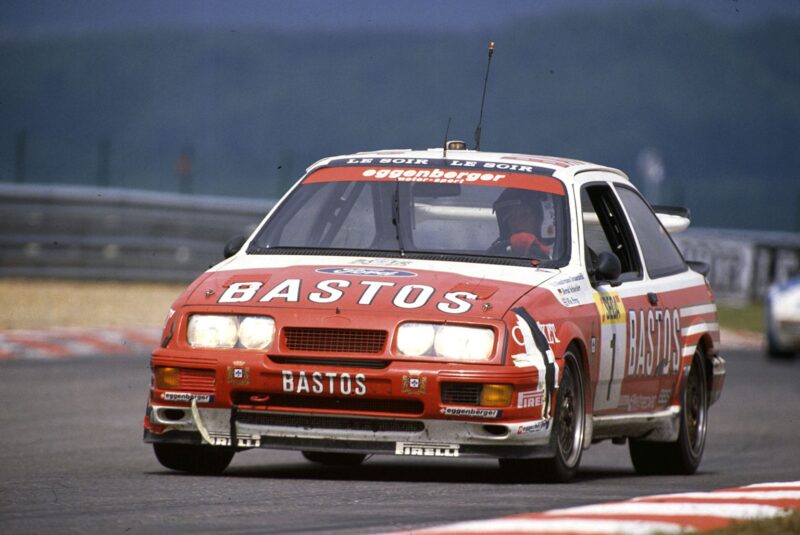
Percy was successful in European Touring Cars with TWR Rover SD1 and Ford
Motorsport Images
“For ages I’d been on at Tom to let me drive one of the Jaguar Group C cars. He always said, ‘No, Winston, you’re my touring car man.’ But he finally agreed to let me have a run at a Paul Ricard test in the Silk Cut XJR-6. I can visualise it now. All those proper superstar drivers there in the Ricard pitlane, Warwick, Cheever, Watson and co. Do I really want to do this? Strapped in, ignition, pump, pump, starter, and that bloody V12 bursting into life just behind my ears. Out onto the long circuit. Past the pits first time, on the radio, everything OK? Yes, thank you. Second lap, everything OK? Yes, thank you. Third lap I’m on everybody else’s time. Next day it’s pissing with rain, nobody else wants to know, so I go round and round, the water comes in faster than it goes out. When you accelerate it sloshes into the seat, when you brake it sloshes down to the pedals. Day three it’s dry and I’m on the long back straight and there’s a single-seater in front of me. It’s Alain Prost in the F1 McLaren. He’s flat out at 190mph, I go past him at 210mph. Of course, at the end of the straight I stay wide and he comes storming through, but that’s how fast the Jaguar was in a straight line.” Win’s reward was a Le Mans ride in 1986, in the third Silk Cut XJR-6 with Gianfranco Brancatelli and Armin Hahne. They were lying fourth at 2am when a driveshaft let go.
For Le Mans 1987 Tom nominated Win as a reserve in the Jan Lammers/John Watson XJR-8, and let him qualify, but told him he wouldn’t be used in the race. “Of course I wasn’t happy, but he was the boss. Then some time after midnight I’m asleep in the caravan, and Tom wakes me up. He sits on the bed and says, `Jan’s out in the car now, but Wattie’s not well. I want you to get ready.’ Of course I was delighted. I got changed, had something to drink, went to see the physio, and around 2.30am I’m in the car and accelerating out into the darkness. Past the pits first time, Tom says on the radio, ‘You OK?’ I say, ‘All fine.’
“On my second lap there was a shunt at Indianapolis, flags, bits everywhere, but I steered through it and reckoned I’d missed everything. But I must have picked up something in a tyre. That was the first year we had digital read-outs on the dash, and there was a button for each of the four tyres. If one of them went red you could press it and the fuel gauge would become a tyre temperature gauge, showing you the heat in that tyre. If it was high you could back off and come in. In testing we’d deliberately deflated a tyre, and it worked brilliantly. But the boys hadn’t realised that in a long race the insides of the wheel arches got covered with rubber and closed the sensors off. So having non-functioning technology was worse than having no technology. Going down the Mulsanne on my third lap the car started to buck a bit. But the dash read-out was all OK, so I pressed on. Just before the kink, absolutely flat chat, well over 220mph with the tacho showing top revs, the right rear tyre exploded.
“It tore the rear wing off. At once the car turned straight into the barriers and took off, looping backwards into the night sky. It seemed to happen in slow motion, and I had time to think, This is me, gone. I even thought of Jo Gartner, who’d been killed on the Mulsanne the year before. The car was twisting in the air like a leaf in the wind, then it came down into the Armco — since Jo’s death they’d increased it from two layers to three — then it rolled over again and again, ricocheting from side to side down the road. Finally, after a third of a mile, what was left of the centre of the car fell back onto its floor and stopped. Just a tub, no wheels, no engine, no bodywork, no screen, nothing. Where my helmet had banged along the road it was worn through to the cloth lining. But I didn’t have a bruise.
“I scrambled out of the remains — absurdly, I remembered to unplug the radio lead to my helmet, because Tom always gave us a bollocking for forgetting to disconnect the radio — and I got a lift back to the pits. Martin Brundle, who was in another of the Silk Cut Jaguars, had radioed in that it looked bad. Tom was waiting for me, and he was as white as this plate. The safety car was out for nearly two hours while they cleared up the mess.
“Sunday evening, flying home with Tom in his plane, I asked why he hadn’t been going to let me race. He said, ‘I had a dream last week that one of my cars crashed, and the driver was killed. It was you.’ Tom was tough, you wouldn’t have thought he’d take any notice of something like that. But there were two sides to him. He let me down many times, promised me things that never happened. But in my time working with him, the positives far outweighed the negatives. He was good to me.”
Win did Le Mans ’88 for Nissan in a March V8 turbo: “a lot of power, but a disaster of a car”. And his touring car career continued to flourish. Having won another Donington 500Kms in one of Tom’s Rovers, in 1989 he won the Spa 24 Hours again, this time in an Eggenberger Sierra with Bernd Schneider and Gianfranco Brancatelli. And then at the beginning of 1990, at Walkinshaw’s behest, he and Rosemary upped sticks from Dorset and moved to Australia.
Walkinshaw had the Holden Special Vehicles road car operation in Melbourne, and wanted Win to set up and manage a Holden Racing Team, and drive for it. The high point came that first year with a prestigious victory in the Bathurst 1000, Australia’s 620-mile classic on the demanding Mount Panorama road circuit, sharing with Aussie Allan Grice. “When I phoned Tom after the race and told him we’d won, he went absolutely quiet. Then he said, ‘Is there any way they can dump the car?’ Which meant, could it fail post-race scrutineering? I said, ‘There isn’t a scrutineer in the world who can fault that car.’ Because I knew that if I, the Pom, was found to be remotely iffy in any way I’d be flung out at once. Some of the other cars were trying all sorts, gas under the seat, nitrous in the turbo for qualifying. We took them all on with a clean car, and we won.”
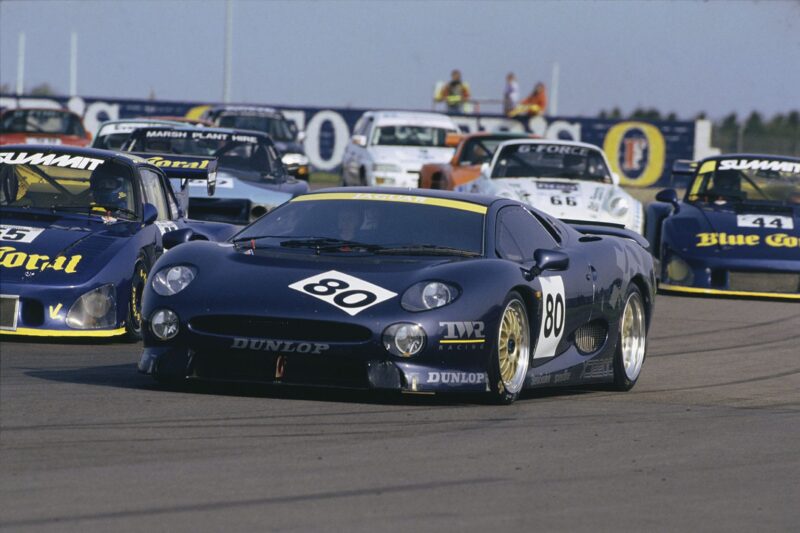
Percy was one of the few to have raced Jaguar’s XJ220 supercar, here in British GT in 1993
Motorsport Images
It was while Tom and Rosemary were living in Australia that they had the phone call every parent dreads. Their son Matthew had been killed in a car crash in Dorset. “Doing 40mph, he had to swerve to avoid two cyclists in the middle of the road. He hit the bank, turned over, and the seat belt bracket broke his neck. The cyclists didn’t stop. Tom was very nice about everything, said I could do whatever I wanted. After the funeral I decided to get back to Australia and throw myself into the job. At Bathurst in 1991 Allan and I were second; one Nissan beat us. The Nissans had a brake cooling problem and they’d opened up the grille to duct extra air to the brakes, which was totally illegal, but I decided not to protest. I’d made so many good friends in Australia, and I didn’t want to have that hanging over me. We would have won it, no question. It took me a long time to confess that to Tom, and he really bawled me out for it, of course.”
Lots more stories: like the Jaguar XJR15 races run at the 1991 British and Belgian Grands Prix. “The XJR-15 was a beautiful, powerful car, but evil to drive. At Spa I went from sixth to fifth to fourth, then through Blanchimont, 180mph and no rear wing, bloody quick, Derek Warwick lost it right in front of me. In the dust cloud I aimed for where he was, hoping that by the time I got there he wouldn’t be. And he wasn’t, so I was third. In 1993 Tom got me to sort out the XJ220, and then I won a race with it at Silverstone, so Tom decided to take three to Le Mans. My car with David Leslie and Hahne blew a head gasket, but David Coulthard, David Brabham and John Nielsen won the GT class — only to fail post-race scrutineering.”
Once Win became involved in historic racing, his relationship with Jaguar grew further. There was a string of wins in the Martini XJ220 prepared by Don Law, and the ferocious twin-turbo XJR-11. Then came his all-time favourite, Nigel Webb’s glorious D-type, which Win raced prolifically and with great success. “The British GP support at Silverstone in 2003 lives with me particularly — because, although I didn’t know it at the time, it was my last race. Julian Bronson was in his Lister-Chevrolet, I was in Nigel’s D as usual, and we spent the entire race wheel to wheel, drifting through those fast corners side by side. Just glorious.”
A few days later Win was moving a piece of equipment in his garden, “and my back went. After two weeks of pain I had a scan, and the hospital told me I needed an operation for a prolapsed disc. They said it was all quite straightforward — but when I came round from the anaesthetic I was paralysed from the waist down. They’d gone in on the wrong disc, and done irreversible damage to my spine.
“I didn’t feel angry. Naïvely I still thought I would be cured. After seven weeks in hospital they sent me to a rehab centre. When I got there I realised all they were going to do was teach me how to live my life in a wheelchair, look after my bodily functions and that sort of thing. A pretty young therapist with a notepad said to me, ‘Mr Percy, do you often consider suicide?’ I couldn’t believe what I was hearing. I said to her ‘No, I damn well don’t. I want to get out of here and get back to living.’
“I was in the wheelchair for three years. The NHS said they couldn’t spend any more on me because I’d never walk again. But I wanted to keep working at it, so from then on I had to pay for everything myself. Gradually I learned to hold myself up for short periods in a zimmer frame. Then I found a therapy team who hung me from a parachute harness over a slow-moving treadmill, and I worked at trying to move one foot in front of the other until my brain had learned about walking again.
“Then there was the court case. The support I had from friends was unbelievable. He wouldn’t want anyone to know, but it was Martin Brundle who handled all the paperwork and found me a top solicitor. So many people submitted written statements about my career: Stirling Moss, Jackie Stewart, Jack Brabham, Derek Bell, Lord March. The medical authority were going to defend it, they wouldn’t admit liability, and if the verdict had gone the wrong way the legal costs against me could have been half a million. We’d have lost our house, lost everything. After four years, just as it was due to come to court, the medical authority made an offer. Rosemary and I looked at each other, and said, ‘Let’s end it now.’ So we accepted.
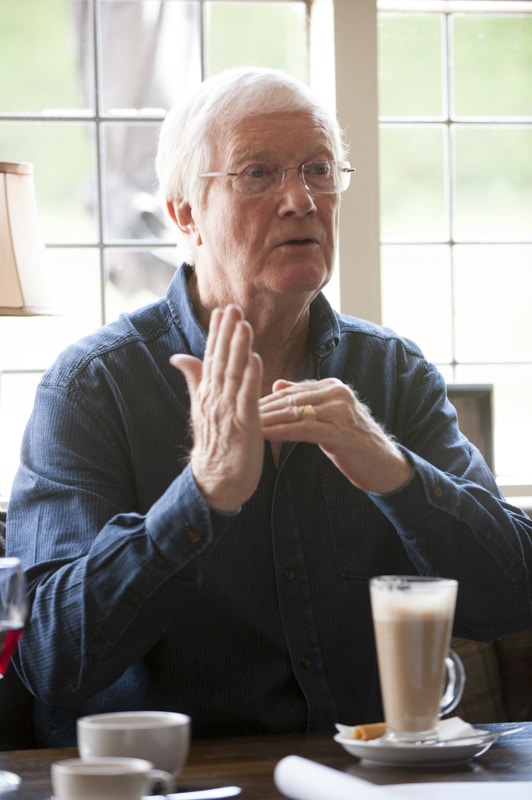
“I’m not bitter. I never gave up: when I got my first wheelchair I was told to specify one much wider, because with my disability they said I would become extremely large. Well, I wasn’t having that. I work out every day as far as I can, so I’m still the right shape. And I have Rosemary always alongside me, which is tremendous. I can drive a road car with hand controls. When I get tired I get a lot of pain: to have lunch with you today, I’ve had pain killers this morning and I’ve got two morphine patches on my back, and tonight I’ll be in bed asleep by 7pm. But the one thing I commit to every year, which I would never miss, is the Goodwood Revival. Charles [Lord March] uses me to monitor driving standards. I address the drivers at the Briefing after the cricket match, and for three days I sit in front of the TV screens watching every lap of every practice session and race. I was warned that this thing could reduce my life expectancy to 10 years. Well, it’s 10 years this August since it happened. I’ll see you at Goodwood as usual in September.
“I’ve been lucky, mate. If I could choose what I’m remembered for it wouldn’t be for driving cars around tracks and winning trophies. I know it sounds corny, but I’d rather be remembered for being a decent bloke.”
There are many more stories, many more cars and races we could cover, but we’ve been talking for four hours. He’s clearly hurting now and it’s time to stop. As I drive back from Dorset, thinking about my lunch with Win Percy, I’m not dwelling on his great drives, his championship titles, his tales from track and pits and motorhome. I’m thinking about how I’ve spent the day with a decent bloke. Win will surely have his wish: that is how he will be remembered.
